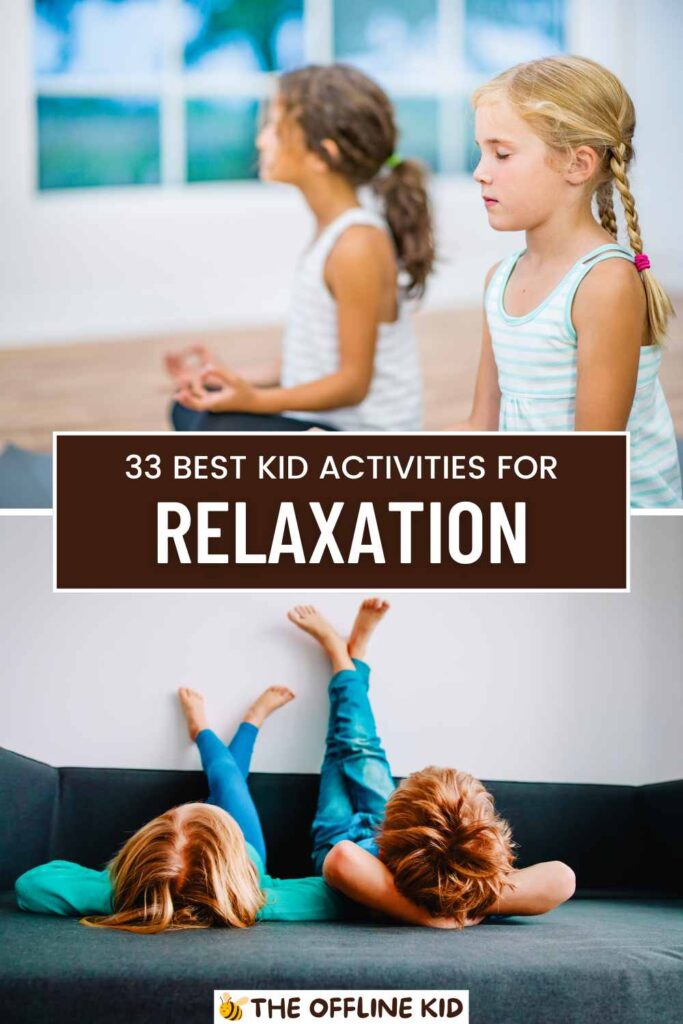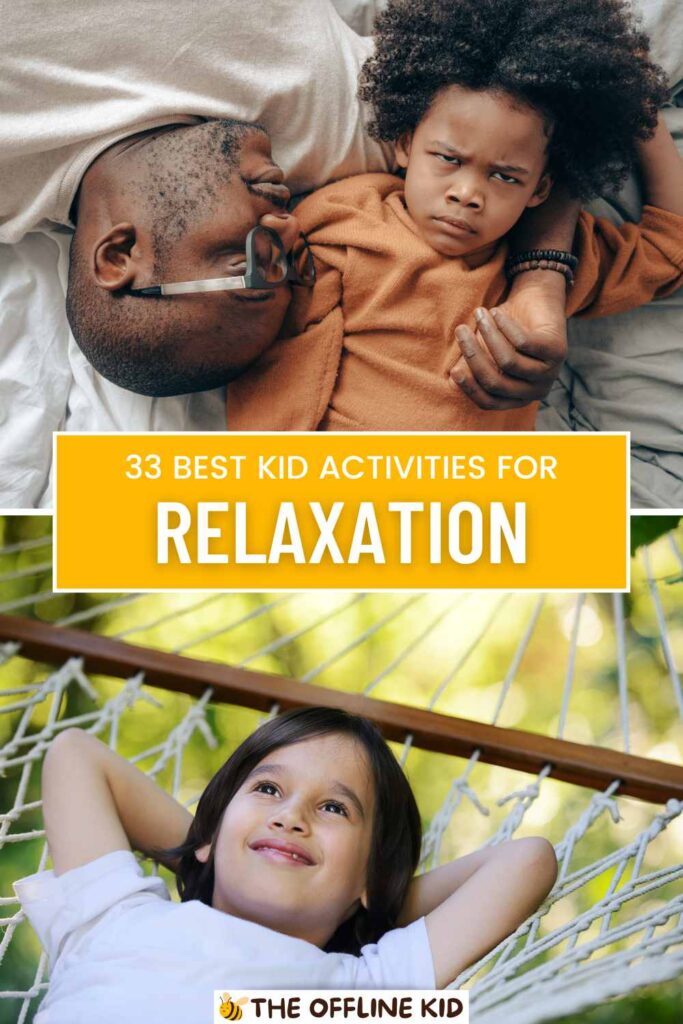Helping kids find relaxation is essential for their well-being.
Discover a variety of fun, soothing activities designed to help children unwind, reduce stress, and enjoy calm moments.
Mindfulness and Meditation
Mindfulness is the practice of being present in the moment, which can significantly benefit children by improving their focus and reducing anxiety.
Teaching mindfulness to kids helps them develop a healthy way to cope with stress and enhances their emotional well-being.
Simple Meditation Practices
Guided Meditations for Children
- Short Guided Sessions: Use apps or online resources that offer brief, age-appropriate guided meditations. These can range from 5 to 10 minutes and help kids focus on their breathing and thoughts.
- Bedtime Meditations: Incorporate guided meditations into bedtime routines to help children wind down and prepare for a restful sleep.
Breathing Exercises
- Deep Belly Breathing: Teach kids to place their hands on their bellies and take slow, deep breaths, feeling their stomach rise and fall.
- Balloon Breathing: Have children imagine inflating a balloon as they inhale deeply and slowly release the air as they exhale, helping them visualize their breath and calm their minds.
Mindfulness Games
Body Scan Game Guide kids through a body scan meditation where they focus on different parts of their body, noticing sensations without judgment. This helps them develop a deeper awareness of their physical state and promotes relaxation.
Mindful Listening Activities
- Nature Sounds: Sit outside or near an open window and have children close their eyes, focusing on the sounds around them. Ask them to identify different sounds, encouraging them to stay present.
- Sound Identification Game: Play various sounds (e.g., birds chirping, waves crashing) and ask kids to guess what they are, enhancing their listening skills and mindfulness.
By incorporating these mindfulness and meditation practices, you can help children develop a sense of calm and presence that will benefit them in all aspects of their lives.
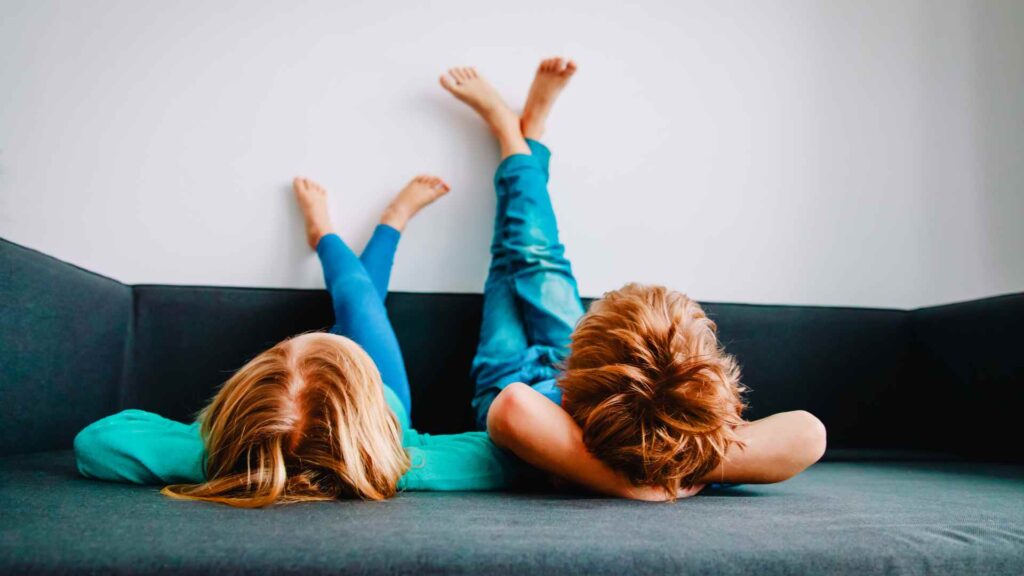
Creative Arts and Crafts
The Therapeutic Benefits of Art
Engaging in creative activities allows children to express themselves, process emotions, and develop fine motor skills.
Art can be a powerful tool for relaxation, providing a calming outlet for kids to channel their energy and creativity.
Drawing and Coloring
Mandala Coloring Books
- Relaxing Patterns: Mandalas are intricate designs that can be very soothing to color. Provide children with mandala coloring books or printable sheets to help them focus and relax.
- Color Choice: Encourage kids to choose colors that they find calming or that make them happy, enhancing the therapeutic effect.
Free Drawing Time
- Creative Freedom: Allow children to draw whatever they like without any specific guidelines. This freedom can be very relaxing and empowering.
- Drawing Prompts: If they need inspiration, provide simple prompts like “draw your favorite place” or “draw how you feel today.”
Painting
Watercolor Painting
- Easy Cleanup: Watercolors are easy to use and clean up, making them a great option for stress-free painting sessions.
- Blend and Flow: Show children how to blend colors and let them watch the paint flow on the paper, which can be very calming.
Nature Painting Projects
- Outdoor Inspiration: Encourage kids to paint scenes from nature, such as flowers, trees, or animals. This not only relaxes them but also helps them connect with the natural world.
- Leaf Printing: Collect leaves, dip them in paint, and press them onto paper to create beautiful leaf prints. This combines the calming effects of nature and art.
Crafts
Simple Origami
- Step-by-Step Instructions: Teach children to fold simple origami shapes like cranes, boats, or frogs. The process of folding paper can be very meditative and satisfying.
- Origami Kits: Provide kits with pre-cut paper and instructions to make the process easier and more enjoyable.
DIY Stress Balls
- Materials Needed: Balloons, flour or rice, and a funnel.
- Instructions: Help kids fill balloons with flour or rice using a funnel, then tie off the balloons. They can decorate the stress balls with markers or stickers. Squeezing the stress balls can be a great way for kids to release tension and relax.
By engaging in these creative arts and crafts activities, children can find joy and relaxation while exploring their creativity. These projects provide an excellent way for kids to unwind and express themselves in a calm and supportive environment.
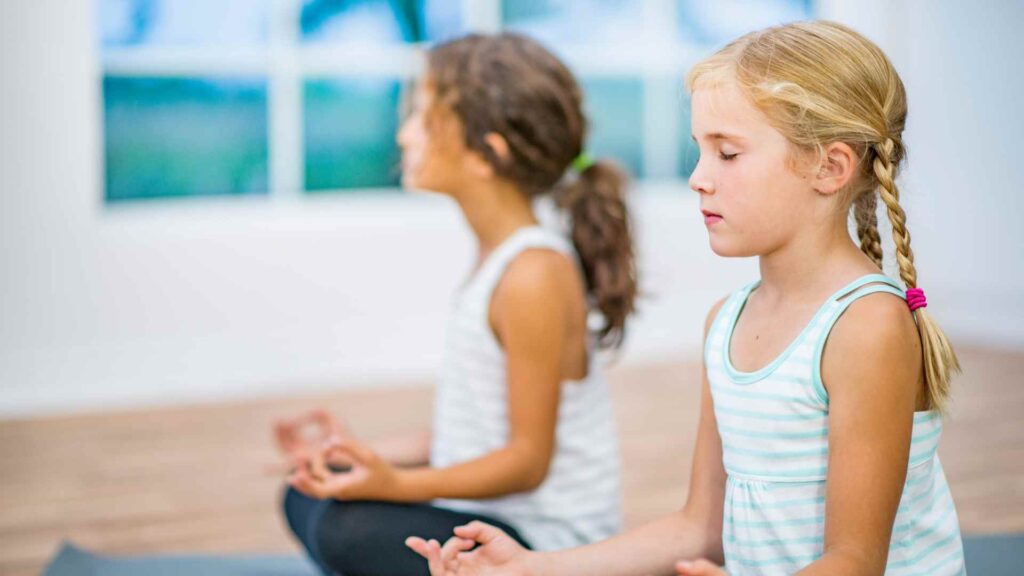
Nature and Outdoor Activities
Nature Walks
Scavenger Hunts in Nature
- Themed Hunts: Create scavenger hunt lists with themes like “find something green,” “spot a bird,” or “collect different types of leaves.” This encourages kids to explore and pay attention to their surroundings.
- Mindful Observation: Teach kids to observe the details in nature, such as the patterns on leaves or the sounds of different animals, promoting mindfulness and relaxation.
Observing Wildlife
- Bird Watching: Provide binoculars and a bird guidebook to help kids identify different species. This activity can be both calming and educational.
- Insect Exploration: Equip children with magnifying glasses to observe insects up close, teaching them to appreciate the small wonders of nature.
Gardening
Planting Flowers or Vegetables
- Hands-on Activity: Let kids dig, plant seeds, and water their own garden plots. This hands-on activity is grounding and helps them connect with nature.
- Watching Growth: Teach children the patience and satisfaction of watching their plants grow and eventually harvesting vegetables or enjoying blooming flowers.
Creating a Small Herb Garden
- Indoor or Outdoor: Set up a small herb garden on a windowsill or in the backyard. Herbs are easy to grow and maintain.
- Scent and Taste: Allow kids to smell and taste the herbs they grow, engaging their senses and enhancing the relaxing experience.
Outdoor Play
Gentle Yoga in the Park
- Yoga Mats: Bring yoga mats to a quiet spot in the park and guide children through gentle yoga poses. The combination of movement and fresh air is very soothing.
- Nature-Inspired Poses: Use poses named after animals or natural elements, like “tree pose” or “cobra,” to make it fun and relatable for kids.
Cloud Watching and Stargazing
- Daytime Relaxation: Lie on the grass with kids and watch the clouds. Encourage them to identify shapes and stories in the clouds, fostering creativity and relaxation.
- Nighttime Calm: At night, take a blanket outside and stargaze. Teach kids about constellations or simply enjoy the beauty of the night sky. This can be a very calming bedtime activity.
By incorporating these nature and outdoor activities, children can benefit from the calming effects of being in nature. These activities encourage mindfulness, physical movement, and a deeper connection to the natural world, all of which contribute to a sense of relaxation and well-being.
Physical Relaxation
Gentle Yoga and Stretching
Kid-Friendly Yoga Poses
- Animal Poses: Introduce fun poses like “cat-cow,” “downward dog,” and “cobra.” These poses are easy for kids to remember and perform.
- Balancing Poses: Teach children poses like “tree” and “eagle,” which help improve balance and focus while promoting calmness.
Benefits of Stretching
- Flexibility and Relaxation: Gentle stretching helps increase flexibility and release muscle tension, promoting a relaxed state.
- Simple Stretches: Include easy stretches like touching toes, reaching for the sky, and gentle neck rolls.
Tai Chi for Kids
Introduction to Tai Chi
- What is Tai Chi?: Explain that Tai Chi is a form of martial art that focuses on slow, flowing movements and deep breathing.
- Benefits for Children: Highlight how Tai Chi can improve concentration, balance, and relaxation.
Simple Tai Chi Movements
- Wave Hands Like Clouds: Teach children this gentle, flowing movement to help them relax and focus.
- Parting the Horse’s Mane: Show kids how to perform this calming movement, which mimics the motion of petting a horse.
Massage and Tactile Activities
Self-Massage Techniques
- Hand and Foot Massage: Teach children simple self-massage techniques for their hands and feet, using gentle pressure and circular motions.
- Tennis Ball Massage: Have kids roll a tennis ball under their feet or on their backs to relieve tension and promote relaxation.
Using Tactile Toys and Tools
- Stress Balls and Fidget Toys: Provide children with stress balls, fidget spinners, or other tactile toys that they can squeeze or manipulate to help reduce anxiety and improve focus.
- Soft Blankets and Pillows: Create a cozy relaxation corner with soft blankets, pillows, and stuffed animals. Encourage children to cuddle up and relax in this comforting space.
By incorporating these physical relaxation activities, children can learn to manage stress and tension through movement and tactile experiences. These practices promote a sense of calm and well-being, helping kids feel more relaxed and centered.

Music and Sound
The Power of Music
How Music Affects Mood and Relaxation
- Emotional Connection: Music has the power to evoke emotions and can significantly influence a child’s mood.
- Calming Effects: Listening to soothing music can help lower stress levels, improve focus, and create a peaceful environment.
Listening to Soothing Music
Recommended Playlists for Kids
- Classical Music: Create playlists featuring calming classical pieces like Debussy’s “Clair de Lune” or Pachelbel’s “Canon in D.”
- Nature Sounds: Incorporate tracks that feature sounds of rain, ocean waves, or birdsong to create a serene atmosphere.
- Lullabies and Soft Songs: Include gentle lullabies and soft children’s songs that are designed to soothe and relax.
Nature Sounds and Instrumental Music
- Ambient Sounds: Use recordings of natural sounds, such as forest ambiance or flowing streams, to help kids feel connected to nature and promote relaxation.
- Instrumental Tracks: Play instrumental music, such as piano or harp compositions, to create a calm and peaceful environment.
Making Music
Playing Simple Instruments
- Percussion Instruments: Provide children with simple percussion instruments like tambourines, maracas, or drums. Encourage them to play soft, rhythmic patterns.
- Wind Instruments: Introduce kids to instruments like recorders or flutes. Playing these can be both relaxing and a fun way to explore music.
Creating DIY Instruments
- Homemade Shakers: Help kids make their own shakers using dried beans and small containers. Decorating the shakers can add a fun, creative element.
- Rubber Band Guitars: Create simple guitars by stretching rubber bands over empty tissue boxes. Kids can pluck the bands to create different sounds.
By integrating music and sound activities, children can discover the calming and therapeutic effects of music. Whether they are listening to soothing tracks or making their own melodies, these activities offer a wonderful way for kids to unwind and relax.
Reading and Storytelling
The Joy of Reading
How Reading Helps Kids Unwind
- Escape and Imagination: Reading allows children to escape into different worlds, stimulating their imagination and providing a mental break from daily stress.
- Quiet Time: Reading creates a quiet, focused time where children can relax and enjoy a good story.
Recommended Relaxing Books
Bedtime Stories
- Classic Tales: Books like “Goodnight Moon” by Margaret Wise Brown or “Guess How Much I Love You” by Sam McBratney are gentle and soothing.
- Rhyming Stories: Rhyming books such as “The Gruffalo” by Julia Donaldson or “Room on the Broom” can be very calming and enjoyable for kids.
Calming Picture Books
- Nature-Themed Books: Books like “The Quiet Book” by Deborah Underwood or “The Listening Walk” by Paul Showers help children appreciate the quiet moments in nature.
- Mindfulness Books: Titles like “I Am Peace: A Book of Mindfulness” by Susan Verde introduce children to the concept of mindfulness through beautiful illustrations and gentle stories.
Storytelling and Audiobooks
Listening to Audiobooks
- Audiobook Apps: Use apps like Audible or Librivox to find a wide range of audiobooks suitable for children. These can be played during quiet time or bedtime.
- Narrated Stories: Choose audiobooks with calming narration and gentle background music to help kids relax and fall asleep.
Creating and Sharing Stories
- Story Cubes: Use story cubes or cards to inspire kids to create their own stories. This encourages creativity and can be a fun, relaxing activity.
- Family Storytime: Set aside time for family members to share their favorite stories or create new ones together. This bonding activity can be very comforting and enjoyable for kids.
By incorporating reading and storytelling into their routine, children can find joy and relaxation through the power of words. Whether they are diving into a book, listening to an audiobook, or creating their own tales, these activities offer a wonderful way for kids to unwind and explore their imaginations.
Sensory Activities
Understanding Sensory Play
Benefits of Sensory Activities
- Sensory Development: Engaging multiple senses can help children develop fine motor skills and improve cognitive growth.
- Calming Effects: Sensory play can be very soothing and can help children regulate their emotions and reduce anxiety.
Sensory Bins
Creating Themed Sensory Bins
- Nature Bin: Fill a bin with items like sand, pebbles, leaves, and small plastic animals. This can help kids connect with nature in a tactile way.
- Water Bin: Add water, floating toys, and cups for pouring and scooping. This can be very relaxing and fun for kids to explore.
- Seasonal Bin: Use seasonal items like fake snow in winter or dried corn and pumpkins in fall. Changing the theme keeps sensory bins interesting and engaging.
Ideas for Sensory Bin Fillers
- Dry Ingredients: Use rice, beans, pasta, or oats as the base for sensory bins. These materials are inexpensive and easy to replace.
- Wet Ingredients: Use water beads, slime, or gel beads for a different tactile experience. Ensure supervision with younger children to prevent ingestion.
- Natural Elements: Incorporate natural elements like shells, pinecones, or flowers. This adds an educational aspect to sensory play.
Calming Sensory Activities
Playdough and Slime
- DIY Playdough: Make homemade playdough using flour, salt, water, and food coloring. Adding essential oils like lavender can enhance the calming effect.
- Slime: Create slime with ingredients like glue, baking soda, and contact lens solution. The stretchy, squishy texture can be very satisfying for kids to play with.
Sand and Water Play
- Kinetic Sand: This moldable sand is great for sensory play. Kids can create shapes and structures, which can be very relaxing.
- Water Tables: Set up a water table with cups, funnels, and small toys. Water play is naturally calming and can keep kids entertained for hours.
By engaging in these sensory activities, children can explore different textures and materials in a way that is both fun and relaxing. Sensory play helps them to focus and calm their minds, providing a valuable tool for emotional regulation and stress relief.
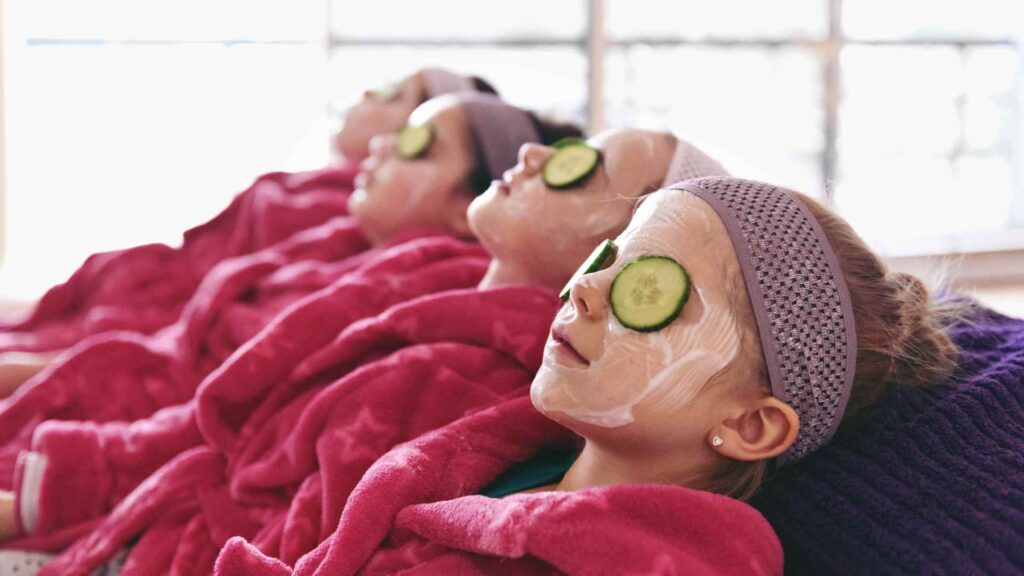
Quiet Games and Puzzles
Puzzles and Brain Teasers
Benefits of Puzzles
- Cognitive Development: Puzzles help improve problem-solving skills, memory, and concentration.
- Stress Relief: The focused attention required to complete a puzzle can be very calming and meditative.
Types of Puzzles for Different Ages
- Jigsaw Puzzles: Choose puzzles with larger pieces for younger kids and more complex ones for older children. Themes like animals, nature, and favorite characters can make the activity more engaging.
- Logic Puzzles: Sudoku, crosswords, and other logic puzzles are great for older children. They challenge the mind and provide a satisfying sense of achievement when completed.
Board Games
Relaxing Board Games for Kids
- Cooperative Games: Games like “Hoot Owl Hoot!” or “Peaceable Kingdom’s Dinosaur Escape” encourage teamwork rather than competition, reducing stress and promoting collaboration.
- Simple Strategy Games: Games like “Connect 4” or “Checkers” offer gentle strategic thinking without being too demanding or competitive.
Cooperative Games
- Team-Based Play: Games that require players to work together towards a common goal can be very rewarding and less stressful.
- Examples: “Pandemic” (family edition) or “Forbidden Island” are great choices that require teamwork and strategic planning.
Card Games
Simple Card Games
- Go Fish: This classic game is easy to learn and can be very relaxing. It helps kids practice memory and matching skills.
- Old Maid: A fun, non-competitive game that encourages matching and can be played with a regular deck of cards.
Solitaire Variations for Relaxation
- Classic Solitaire: Teach children the classic game of solitaire. It’s a great way for them to enjoy quiet, solo play.
- Memory Matching: Lay cards face down and have children find matching pairs. This game helps improve memory and concentration.
By incorporating these quiet games and puzzles, children can enjoy activities that challenge their minds while promoting relaxation and focus. These games provide a wonderful way for kids to unwind and have fun in a calm and supportive environment.
Mindful Breathing and Relaxation Techniques
Breathing Exercises
Deep Breathing Techniques
- Belly Breathing: Have kids place their hands on their bellies and take deep breaths in through their noses, feeling their bellies rise, and then exhale slowly through their mouths. This helps activate the body’s relaxation response.
- Counted Breaths: Teach children to breathe in for a count of four, hold for a count of four, and then breathe out for a count of four. This rhythmic breathing can help calm the mind.
Balloon Breathing Game
- Imaginary Balloon: Ask kids to imagine they are holding a balloon. As they inhale deeply, they should imagine filling the balloon with air, and as they exhale, they release the air slowly, deflating the balloon. This visualization helps children focus on their breathing.
Progressive Muscle Relaxation
Guided Muscle Relaxation for Kids
- Step-by-Step Relaxation: Guide children through a progressive muscle relaxation exercise where they tense and then relax each muscle group, starting from their toes and moving up to their heads. This technique helps release physical tension and promotes relaxation.
- Tense and Release: Have kids squeeze their hands into fists tightly for a few seconds and then release. Repeat with different muscle groups like shoulders, legs, and feet.
Visualization Techniques
Guided Imagery and Visualization
- Safe Place Visualization: Guide children to close their eyes and imagine a safe, peaceful place. It could be a beach, a forest, or their favorite room. Encourage them to use all their senses to explore this place, noticing the sights, sounds, smells, and textures.
- Magic Carpet Ride: Have kids imagine they are on a magic carpet ride, gently floating above different beautiful landscapes. This imaginative journey can be very calming and helps children develop their visualization skills.
By practicing these mindful breathing and relaxation techniques, children can learn to manage stress and anxiety effectively. These exercises provide valuable tools that they can use throughout their lives to find calm and peace in any situation.
